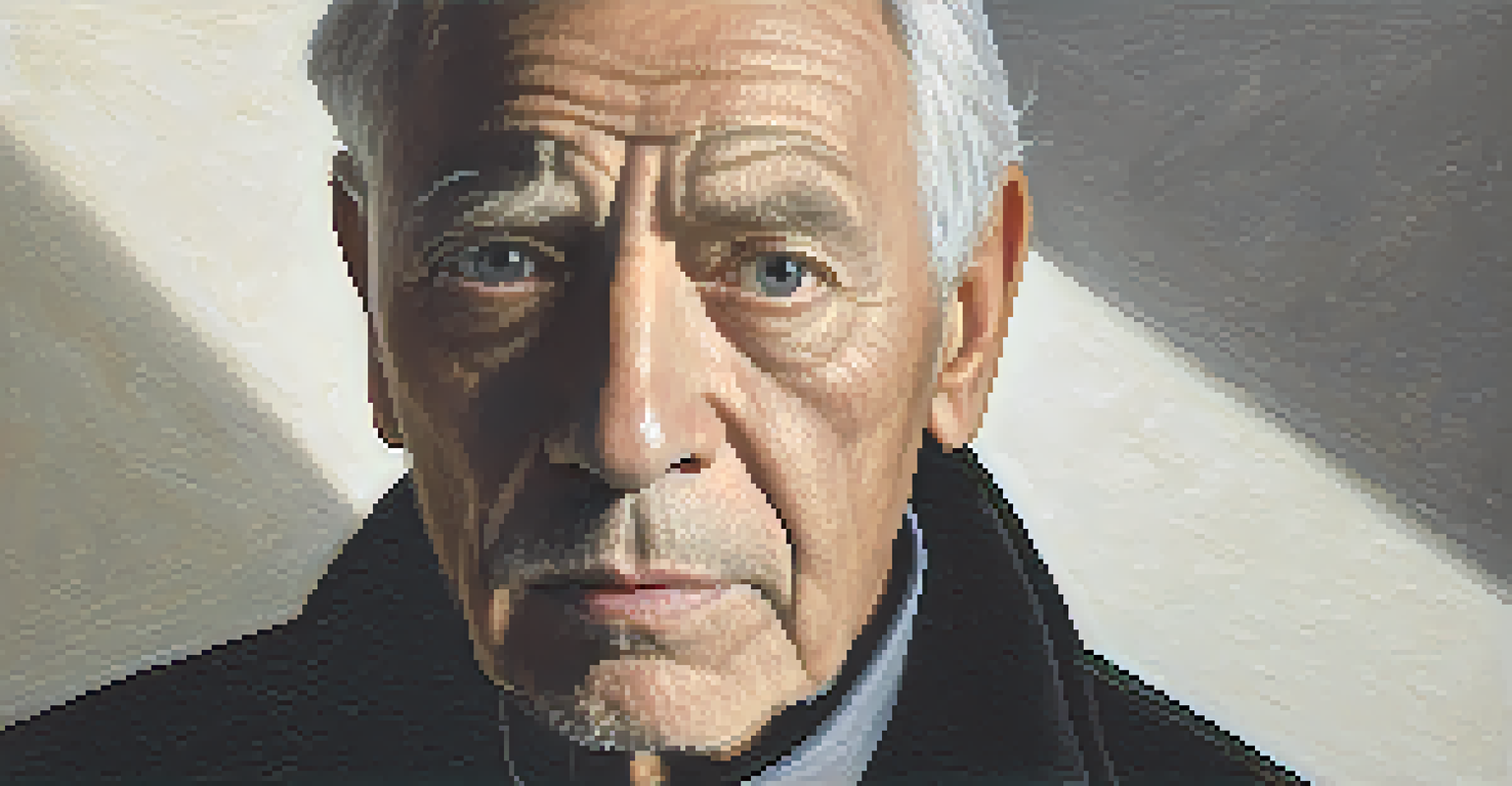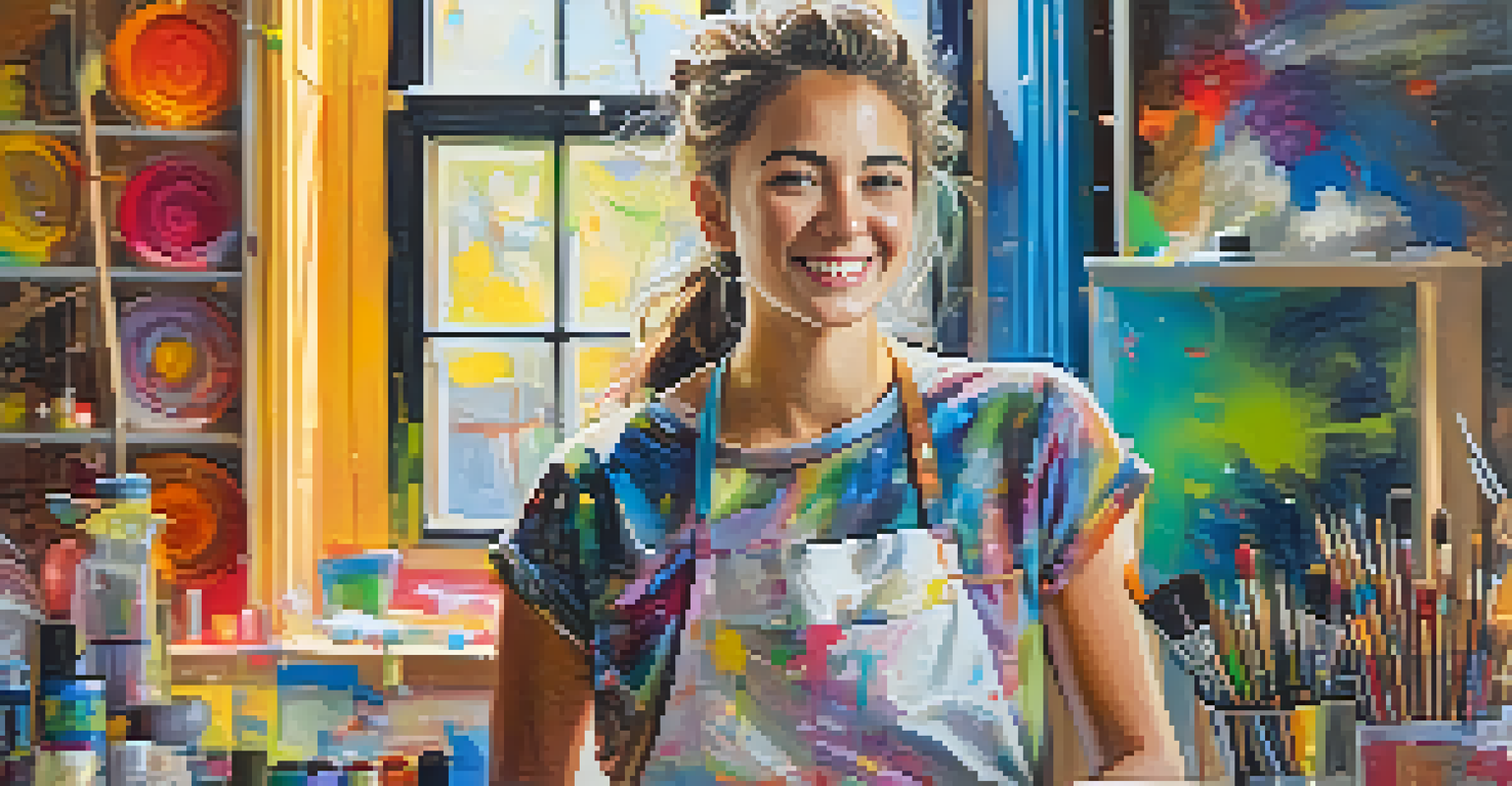The Role of Light in Portrait Painting Techniques

The Importance of Light in Portrait Painting
Light is fundamental in portrait painting, serving as the backbone of the artwork. It influences how we perceive forms, colors, and textures, making it essential for capturing the essence of the subject. Without proper use of light, a portrait may appear flat or lifeless, failing to convey the depth of character that artists strive for.
Light is the first element of design; without it, there is no color, no form, no texture, no shape.
In portrait painting, light helps to define not just the physical features but also the mood and emotion of the piece. For example, a soft, diffused light can evoke a sense of calm and intimacy, while harsh, contrasting light can create drama and tension. This interplay of light and shadow is pivotal in drawing the viewer's eye to specific areas of the portrait.
Ultimately, understanding light allows artists to manipulate their paintings to tell a story or convey a feeling. Whether it's the gentle glow of a sunrise or the stark shadows of a dimly lit room, light enriches the narrative and emotional impact of the artwork.
Types of Light Used in Portrait Painting
There are several types of light that artists can utilize, each producing different effects in their portraits. Natural light, for instance, is favored for its ability to create soft gradients and lifelike colors. Artists often paint outdoors or near windows to capture the ever-changing qualities of sunlight throughout the day.

Artificial light also plays a significant role, particularly in studio settings. Using lamps or flashes can help artists achieve specific lighting effects that may not be possible with natural light alone. For example, a spotlight can create dramatic highlights and deep shadows, enhancing the three-dimensionality of the subject.
Light Defines Portraits' Mood
The use of light in portrait painting is essential for conveying mood and emotion, influencing how forms and colors are perceived.
Additionally, diffused light can soften features, making it ideal for portraits that aim to convey tenderness. By experimenting with different light sources, artists can explore how each affects the mood and perception of their subject.
Understanding Light Direction in Portraits
The direction of light is crucial in portrait painting, as it determines how shadows and highlights interact with the subject's features. A light source positioned in front of the subject can create a flattering, even illumination, while side lighting can emphasize textures and contours. This can add depth and a sense of realism to the portrait.
A painting is not a picture of an experience, but is the experience.
Moreover, backlighting can produce a striking silhouette effect, drawing attention to the outline and shape of the subject rather than its details. This technique can be particularly effective in creating a mood or atmosphere, allowing the viewer's imagination to fill in the gaps.
Understanding the implications of light direction empowers artists to make intentional choices that align with their artistic vision. By manipulating light direction, they can highlight certain features while downplaying others, guiding the viewer's gaze precisely where they want it.
The Role of Color Temperature in Lighting
Color temperature refers to the warmth or coolness of light and can significantly affect the mood of a portrait. Warm light, like that from a sunset, can evoke feelings of warmth and nostalgia, while cool light, such as daylight on a cloudy day, can create a more subdued or somber atmosphere. Artists often choose their light source based on the emotional tone they want to convey.
For instance, an artist might use warm tones to highlight a joyful expression, enhancing the subject's vibrancy. Conversely, cooler tones might be employed to suggest introspection or melancholy, adding layers to the subject's emotional state. This thoughtful consideration of color temperature can transform a simple portrait into a compelling narrative.
Direction and Color Temperature Matter
The direction of light and its color temperature significantly impact the portrayal of the subject, enhancing depth and emotional tone.
By blending different color temperatures, artists can create dynamic contrasts that further enhance their work. Understanding how these temperatures interact with skin tones and backgrounds is essential in achieving a balanced and harmonious composition.
Using Shadows to Enhance Portrait Depth
Shadows are as important as light in portrait painting, adding dimension and depth to the artwork. They help to define the shape of the subject’s features, creating a three-dimensional effect that draws the viewer in. By carefully placing shadows, artists can create a sense of volume, making the portrait feel alive.
The use of shadows also contributes to the overall mood of the painting. For instance, deep shadows can evoke a sense of mystery or drama, while lighter shadows may suggest a more cheerful or relaxed atmosphere. This contrast can significantly alter the viewer's perception, encouraging them to engage with the portrait on a deeper level.
Moreover, understanding how to manipulate shadows allows artists to guide the viewer’s focus. By contrasting light and dark areas, they can highlight specific features, like a subject's eyes or smile, making those elements pop and inviting the viewer to explore the portrait further.
Capturing Natural Light in Portraits
Capturing natural light effectively can elevate a portrait from ordinary to extraordinary. Artists often take advantage of the golden hour—the hour after sunrise and before sunset—when the light is soft and warm. This time of day is perfect for creating portraits that feel alive and connected to nature.
To successfully capture natural light, artists should consider their subject’s positioning. By turning the subject towards the light source, they can create flattering highlights on the face and avoid harsh shadows. This technique helps to enhance the subject's features while maintaining a natural look.
Experimentation Enhances Artistic Voice
Artists should experiment with different light setups and sources to discover their unique style and create captivating portraits.
Additionally, understanding the effects of changing light conditions throughout the day can help artists plan their work effectively. By observing how light interacts with their subject at different times, they can choose the ideal moment to create a lasting portrait.
Experimenting with Light in Portrait Painting
Experimentation is a key component of mastering light in portrait painting. Artists should feel encouraged to try different light setups, angles, and sources to discover what resonates most with their style. By pushing boundaries, they can find unique ways to express their vision and create captivating portraits.
For example, an artist might use colored gels on their light sources, introducing unexpected hues that can alter the mood of the portrait. Such experimentation can yield surprising results, leading to a more innovative approach to traditional portraiture.

Ultimately, the journey of exploring light in portrait painting is about finding one's voice. Each artist's interpretation of light is unique, and through practice and experimentation, they can develop a signature style that sets their work apart from others.